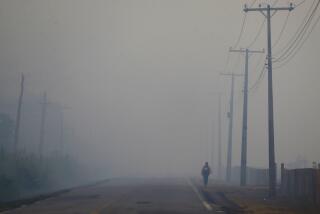Disappearing Amazon: Brazil’s Policies
- Share via
A summary of Brazil’s shifting policies on the Amazon.
* Before October, 1988: The Brazilian government spent hundreds of millions of dollars under a development policy for the Amazon region that encouraged pioneers to resettle the jungle and to share in its bounty. They built a 900-mile-long highway with World Bank funds, offered subsidies to farmers and implemented a taxation system that encouraged the practice of slash-and-burn forest clearing by farmers and ranchers.
* October, 1988: Brazilian President Jose Sarney announced a plan to restrict government subsidies for agriculture in the Amazon region.
* April, 1989: Sarney introduced “Our Nature,” a plan to provide a “permanent and economically viable development program, ecologically adequate, politically balanced and socially just.” Among the plan’s provisions: the end of financial incentives for cattle ranching; government control of mercury, which is used by gold miners and is a major source of water pollution; rehabilitation of the most badly damaged mining areas, and the identification of “agro-ecological” areas that could be developed without environmental damage.
* June, 1989: In a change of position, the Brazilian government decided to link its huge foreign debt to conservation projects by considering “debt-for-nature swaps” with the industrialized nations that hold the notes.
* June, 1990: “Operation Amazon” was introduced by President Fernando Collor de Mello. The plan involves the deployment of army personnel in the battle against the illegal burning of forested lands.
* December, 1990: The Brazilian government approved the first major plan to reforest 2.5 million acres of the vanishing Amazon at an estimated cost of more than $3 billion.
* July, 1991: Brazil appealed to members of the Group of Seven major industrialized nations to support a $1.2-billion international program to save the Amazon rain forest, and to promote “green” development. Brazil’s plan proposed measures ranging from environmental awareness campaigns to the purchase of large tracts of lands to create national parks and preserves.
More to Read
Sign up for Essential California
The most important California stories and recommendations in your inbox every morning.
You may occasionally receive promotional content from the Los Angeles Times.













